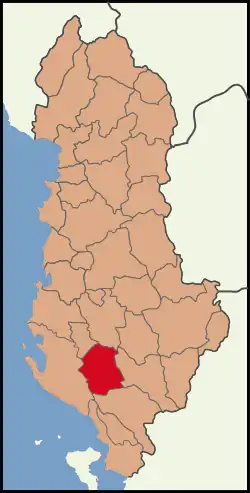Tepelenë District
Tepelenë District (Albanian: Rrethi i Tepelenës) was one of the thirty-six districts of Albania (which were dissolved in 2000). It had a population of 32,465 in 2001, and an area of 817 km².[1] It is in the south of the country, and its capital was Tepelenë. Its territory is now part of Gjirokastër County: the municipalities of Tepelenë and Memaliaj.
Tepelenë District | |
|---|---|
 | |
| Coordinates: 40°20′N 19°57′E | |
| Country | |
| Dissolved | 2000 |
| Seat | Tepelenë |
| Area | |
| • Total | 817 km2 (315 sq mi) |
| Population (2001) | |
| • Total | 32,465 |
| • Density | 40/km2 (100/sq mi) |
| Time zone | UTC+1 (CET) |
| • Summer (DST) | UTC+2 (CEST) |
Tepelenë District is home to a number of bottled water plants. It is also known for a visit by Lord Byron of Great Britain during the 19th century. Such was the impression made that he wrote the poem titled "Mother Albania" depicting the natural beauty of Albania and the loyalty and fierceness of its warriors.
History
At the Vjosa (Greek:Aoos) Narrows ("Aoi Stena") in the district, a Macedonian army barred the way to Epirus and, in 198 BC, a decisive battle, the Battle of the Aous, took place between a Roman army commanded by Consul Titus Quinctius Flamininus and the Macedonians commanded by Philip V. After an attempt of a truce and an inconclusive battle, a shepherd led the Roman army to a point where the Macedonians could be attacked and the Romans won the battle.
Administrative divisions
The district consisted of the following municipalities:
References
- Districts of Albania, statoids.com